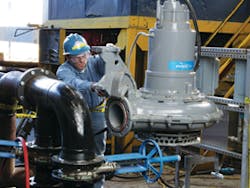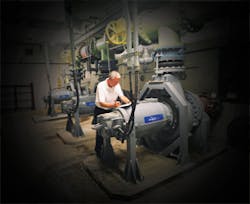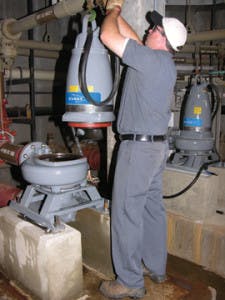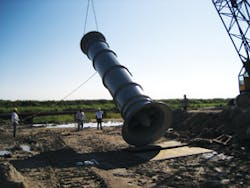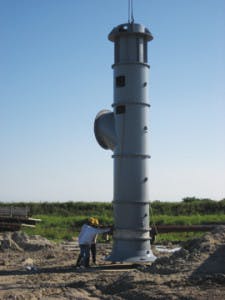Managing Speed and Demand
“In municipal water, there are certain times of the day where everybody’s using water, and therefore, the pump is going to be running full out,” says Brian Cook, commercial product manager for ITT Corporation’s Goulds Pumps.
“During other times of the day, a few people are home, so water usage is much reduced,” he adds. “You don’t need to have the pump running full speed at that point. As a matter of fact, they may not even need to be on. But unless you’ve got some kind of a control system to power back or turn it off, you’re going to be wasting energy.”
One way to insure pump efficiency is to employ a variable speed system, which uses a sensor in the piping to detect decreased demand and adjusts the speed accordingly, so that the appropriate amount of water is deployed to match what the customer needs. Cook notes that, although a variable speed system can save up to 70% of the energy needed to run a full speed pump all the time, variable speed drives are not considered often enough, especially in a variable flow pumping environment.
Variable frequency drives “basically utilize what’s referred to as the cube rule or the affinity laws or curves, so by reducing the speed of the motor by 10%, we can typically save about 27% of the energy usage,” says John Masters, director of sales of Danfoss Water and Wastewater. “By controlling the speed of the pump based on the process requirements using a variable frequency drive, you can increase efficiencies in the system.”
Drives are available in sizes from fractional horsepower up to thousands of horsepower, says Masters. “There’s quite a wide range of applications: constant pressure, controlled level in wastewater, wet well, even chemical feeds for water chemicals. Irrigation is a common application where controlling typically is based on pressure or level, and speed is matched to the demands of the irrigation.”
Communities are encountering the need for higher pressures to accommodate outlying areas, so they’re building more water towers and more water reservoirs. These drives can also be used in conjunction with pumps for pressure, thereby boosting pressure to outlying areas while maintaining pressure onsite, he says.
Masters also points out that often the best choice for variable frequency drives should be determined by considering efficiencies, temperature limitations, and sizing them according to the pumps.
Refined Focus
While the heavy focus upon the United States’ aging infrastructure is on pipes, there are issues with pumps that need to be addressed, Cook says. “You are looking at a lot of development in rural water,” he says. “In major municipal areas, there obviously is some piping that needs to be replaced, but from a pump standpoint, they are in reasonably good shape.
“In the rural areas where they may never have had a central water supply or mainline piping, that’s where the big changes are going on right now,” he adds. “You are finding small towns all over the place that are just now going on a central well. They’re adding centrifugal or turbine pumps to bring the water up to the surface, or if they happen to be near a large lake or water source, they are usually using turbine pumps to pull the water out of the surface water.”
In some municipalities, the aging infrastructure isn’t sound enough to withstand the higher pressures required as piping is added to the outer systems; leakage and revenue loss result, says Masters. “Using variable frequency drives can maintain a constant pressure, eliminating the overpressuring of the water system and help reduce revenue water loss,” he says.
Richard Hanson, commercial business unit director for SyncroFlo, says it is sometimes cost-effective to replace
Treated water makes its way into the water supply, and pumps are an important part of that process.
a pump or a pump system based on energy savings as a product ages and becomes less energy-efficient.
It is relatively easy to determine that, “If you’ve got a typical domestic water booster serving an office building, the only way to ensure we have enough water pressure is to turn on pumps in hand and just run them continuously,” says Hanson. “A 10-horsepower motor where electricity is 10 cents a kilowatt-hour will burn about $4,000 worth of electricity per year. We know the buildings are unoccupied completely half the time, maybe more. You’re wasting $2,000 a year per 10 horsepower-worth of pump that you have to keep running. With the right study, it’s pretty easy to cost justify either complete replacement or significant restoration of pump systems like ours.”
Hanson says even if a pump is turning on and turning off the way it’s supposed to, there can still be some significant energy savings if the pumps weren’t selected for the current demand.
Certification Equals Efficiency
Treated water also makes its way into the distribution system, and, as Cook points out, pumps are an important part that process. But delivery alone is only part of the equation.…
“One of the things that goes into how pure the water is coming out of the system is what the material is inside the pump and how the pump is made,” says Cook. “Just as piping and valves and other things in the line have some bearing on the purity of the water, so does the pump. The objective is to have as hygienic a product as possible and one that isn’t subjective to corrosion or to placing contaminants in the water as it is going through the product.”
Routine pump maintenance
One factor that is gaining increasing importance is ANSI 61—sometimes called the NSF 61—certification, notes Cook. ANSI 61 is one of several certifications and tests introduced over the past few years. Although there are other certifications beyond ANSI, Cook predicts that those who have pumps used primarily for water purity will be seeking ANSI/NSF 61 certification if those pumps aren’t already certified (the other most common is a 3A international certification).
“That’s primarily a potable water certification,” says Cook. “One of the certifying agencies tests the product for what materials are in the pump and the potential for corrosion, leaching of chemicals or metals or anything else into the water going through the product.”
According to Cook, ANSI 61 “basically started out as a certification for pumps, piping, and tanks used in milk production, but it’s spread over the past few years, so it’s being recognized more for things like pharmaceuticals and general food and beverages such as soft drinks and juices.”
The objective of the certification is to ensure there are no rough spots, pipe bends, or design elements inside the pump that would cause bacteria to grow, Cook says.
“What typically happens is they’ll run a process for a few hours, shut it down, and clean it out, so it has to be a product that is very easy to clean,” he adds. “Often, it is designed so it can be cleaned in place and not taken apart.
“They will run caustics and chemicals through the pump, the piping, the valves, and everything else in the system, and clean it that way rather than try to disassemble everything, which was the traditional way of doing it,” says Cook.
Hanson says his company is reacting to the technical reality that water is becoming more corrosive. SyncroFlo
Infrastructure rehabilitation must include pump repair and replacement.
has changed its standard to stainless steel for any of the wetted parts where brass was previously used. The company has an NSF 61 certification for its domestic water booster pumping system.
“I think it’s related to the chlorination methods water departments are using,” says Hanson. “They’re changing to chloramine and it gives you a better residual chlorine, but it’s more corrosive. We’ve seen problems throughout the years in different areas with bronze or brass corroding.”
Supersizing Gone Wrong
Cook says the biggest mistake municipalities and engineers make when choosing pumps is to oversize them.
“It’s a very common practice in the pumping industry to pick a pump that has much more capacity than is really needed,” he says. “People tend to say they want to make sure they’re safe, that the pump is not going to be running too far back on its curve and to make sure they have enough water; so maybe down the road, they’ll need more, and so they’ll get a bigger pump now.”
The problem with that is that energy is sacrificed, “because it takes a bigger motor, and it takes more electricity, diesel fuel, or whatever else you are using to power your product to run a large pump,” explains Cook. “The potential savings and not having to add another pump later on is far outweighed by the cost of energy in the meantime.”
Masters says that oversizing can be a mistake. “The nature of the industry itself is that the communities have provided funding and designed a system based on something they believe is going to happen 20 years down the road,” he says. “So they are oversizing everything, including the pumps. One of the benefits of having variable frequency drives on it with oversized pumps is you can reduce the speed of the pumps to match the demand today rather than 20 years from now.”
For many communities, embracing new technologies can be a challenge.
Hanson agrees with others in the industry that pumps are often initially oversized. He says, “If the pumps were originally oversized and some redundancy is added to the sizing of the individual pumps, and then to save water efficiency in a building that is 20 or 30 years old, the high-flow plumbing fixtures are replaced with low-flow fixtures, and now the pump system is even more oversized. You can justify installing a smaller pump system, which by nature is going to be more efficient.”
Technology is the Future
While the nation focuses on the underground pipe infrastructure, technological advances in pumps play a pivotal role in addressing such factors as water quality, efficiency, and conservation.
New technologies, like the Flowstation by Control Microsystems, feature pump-up and pump-down applications, built-in Web, and smartphone functions that allow the user to obtain status, alarms, and control functions. They can also be programmed for various operational characteristics during peak and off-peak electrical power periods.
“Your lift station might act differently at 6 p.m., because that’s a point in time where electricity costs the utility—in this case the water utility—a lot more,” says Steve Goodman, Vice President of Marketing for Control Microsystems. “Built into [their] configuration is the capability for electrical peak and off-peak pumping schemes.”
With “the capability of sending you an e-mail and SMS messages as well,” Goodman points out that these technologically advanced controllers are “really good for lift station applications on the wastewater side.”
Mike Murazzi, sales manager and technical engineer for Morrison Pump, believes the biggest mistake entities make when it comes to using pumps is embracing old technology to the exclusion of newer technology.
“We find a lot of engineers request something that’s old technology just because it’s been around a long time; they haven’t been that open to new technology that is better for the environment,” says Murazzi. “We do CNC machining, and we do a lot more on the computers with a lot more detail, and some counties and states won’t approve it because it’s more modern than what they’re looking for; they don’t understand it.”
Murazzi says his company supplies pumps for a lot of projects outside of Florida, but the customers ask for old technology “because they have some old technology pumps that have big, old oil reservoirs that always leak, and you always get drips.
“In California, where you think would be a highly environmentally friendly place, in all of the projects we’ve been doing, the counties ask for oil lubrication,” he says. “We try to tell them we have a better system. But they won’t take it if there is no oil lubrication.”
As for the future of pumping technology, Murazzi sees it going in the direction of more modern manufacturing.
“We’re hoping that we’ll go away from that, and that, as people see the old technologies, they will come back and say they want a more modern pump.”
One of the most notable examples of the role of pumps in water quality is the Florida Everglades. The subtropical wetlands in the southern part of Florida is one of the largest in the world and is key to many species’ habitat, as well as serving as a support system for agriculture and flood control. Its water quality has been compromised by human activity, and legislation has been enacted over the years to restore the Everglades and address problems relating to water quality, quantity, and restored water flow.Among the many applications for Morrison Pump Company products is the placement of pumps in the Florida Everglades for its restoration. The company also supplies pumps to entities such as the US Army Corps of Engineers and the South Florida Water Management District and other large water districts. Some 50 of the company’s axial flow and mixed flow pumps are being used in the Everglades restoration project.Mike Murazzi, who is a sales manager and technical engineer for Morrison Pump, says new technology has enabled his company to offer a system that is not only efficient, but also sensitive to the environment. Murazzi explains that, in the Everglades restoration, large quantities of water must be moved.
“Because you are diverting water and storing water, you’re doing natural treatment of water,” he says. “Our pumps, and similar pumps being used in the Everglades restoration, are going to be very high-capacity pumps that are going to run almost all of the time.”
